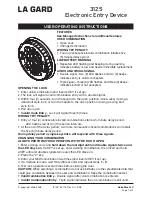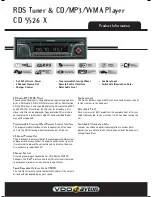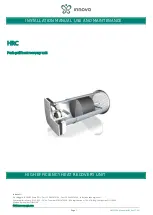
5
CONTROL VALVE FUNCTIONS
This glass filled Noryl fully automatic control valve is designed
as the primary control center to direct and regulate all cycles of
a water softener. The control valve can be set to regenerate on
demand (consumption of a predetermined amount of water)
and/or as a time clock (passage of a particular number of days).
The control valve is compatible with a variety of regenerants
andresin cleaners. The control valve is capable of routing the
flow, of water in the necessary paths to regenerate or backwash
water treatment systems. The injector regulates the flow of brine
or other regenerants. The control valve regulates the flow rates
for backwashing rinsing and the replenishing of treated water into
a regenerant tank.
The control valve is designed to deliver high service (27 gpm @
15 psig) and backwash (27 gpm @ 25 psig) flow rates when the
bypass has straight fittings. The control valve uses no traditional
fasteners (e.g. screws), instead clips, threaded caps and nuts
and snap type latches are used. Caps and nuts only need to be
firmly hand tightened because radial seals are used. Tools
required to service the valve include one small blade screwdriv-
er, one large blade screwdriver, pliers and a pair of hands. A
plastic wrench is available which eliminates the need for screw-
drivers and pliers. Disassembly for servicing takes much less
time than comparable products currently on the market.
The transformer power pack comes with a 15-foot power cord
and is designed for use with the control valve. The transformer
power pack is for dry location use only. The control valve remem-
bers all settings for two hours if the power goes out. After two
hours the only item that needs to be reset is the time of day, all
other values are permanently stored in the nonvolatile memory.
The control valve does not need batteries.
When the control valve is used as a down flow softener, two
backwashes always occur. The softener will start regenerant
prefill before regeneration, the prefill starts two hours before the
regeneration time set. During the 2-hour period in which the brine
is being made, treated (softened) water is still available. For
example:regeneration time = 2:00 am, prefill option selected,
downflow softener. Fill occurs at 12:00 a.m., start of backwash
cycle occurs at 2:00 a.m.
The softener will adjust the backwash and rinse cycles automat-
ically
when the
salt dosage
is changed
. Backwashes can
be set to be NORMAL or LONGER. The option selected will
apply to all backwashes. Tables 4 and 5 show the length of the
cycles when the valve is set up as a softener.
REGENERATION STEPS AND PURPOSE:
Brine fill –
Brine tank is filled to dissolve salt for next
regeneration.
Backwash –
Flow through the resin bed is reversed.
Water flows upward expanding and agitating the resin bed.
Brine in –
Brine is educted from the brine tank and pass-
es through the resin bed in a downward flow, thus remov-
ing calcium and magnesium that has accumulated on the
resin beads and is flush to drain.
Backwash –
A second backwash is performed
Rinse –
The resin is now flushed downward at a set
flow rate.
This resettles the bed and rinses out any
remaining
brine
left in the resin bed.
Service –
Softener goes back into service and ready to
soften water.
EXCHANGE CAPACITY DATA
20,000 grain approx. per cu. Ft.
6 lbs. salt-sodium chloride
25,000 grain approx. per cu. Ft.
8 lbs. salt-sodium chloride
30,000 grain approx. per cu. Ft.
15 lbs. salt-sodium chloride
Note:
To convert parts per million (PPM) or milligrams per
liter (mpl) to grains divide by 17.1
Example:
Water hardness of 250 PPM
(250 PPM divided by 17.1 PPM/gr.) equals 14.6 gr.
It is recommended that a good grade of solar or pellet salt
be used.
One-gallon water will dissolve approximately 3.0 lbs. of salt
One gallon of saturated brine weighs 10.74 lbs.
Control Valve Function and Cycles of Operation






































